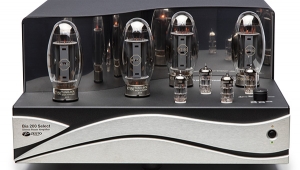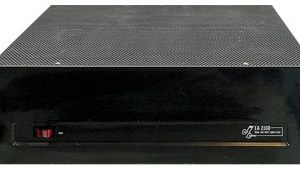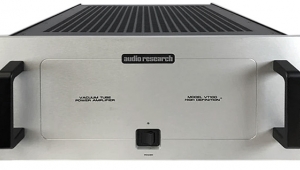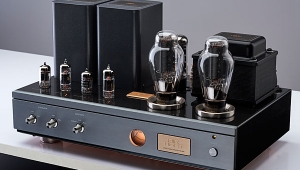| Columns Retired Columns & Blogs |
Cary Audio Design CAD-805 monoblock power amplifier
Lee de Forest filed for a US patent on his "Audion"—the first triode—on October 25, 1906, but never could explain why it worked (footnote 1). It was up to Armstrong and Langmuir, in their pioneering work, to place the hard-vacuum triode on firm scientific ground. When the US entered World War I in April 1917, the Army had to rely on French tubes. Six months later, Western Electric was mass-producing the VT-1 receiving tube and the VT-2 transmitting tube. However, it was only in the decade following World War I, as designers became conversant with the triode amplifier, that many of the crucial elements of tube amplification were nailed down. Technical issues such as coupling two gain stages and selection of optimal coupling impedance were already resolved by the mid-1920s. The triode ruled supreme until the tetrode came along in 1926, followed in 1929 by the pentode from Philips's research laboratories in Holland.
Footnote 1: Lee de Forest incorrectly insisted that the triode's behavior was due to the presence of gas in the primitive audion's soft vacuum. It was left mainly to Armstrong to provide a strong theoretical footing for the triode's behavior and to develop circuits that made use of its properties. Those interested in the early days of sound reproduction and broadcasting should read Tom Lewis's Empire of the Air: the Men Who Made Radio (HarperPerennial Books, 1991). Written in conjunction with an excellent PBS program (which is also available as a videotape), this is the best account I have yet read on the legal disputes between de Forest and Armstrong and between Armstrong and Sarnoff.—John Atkinson
Roarin' '20s amp circuits naturally tended toward simplicity. A single power triode was allowed to handle the entire signal; ie, both negative and positive portions of the waveform. These amplifiers perforce operated in purest class-A: the signal was not shared between two tubes, as it is in a push-pull output stage. These minimalist designs typically used no global negative feedback, feedback not being widely used until the late '30s. This is one of the major reasons why a single-ended design recovers so gracefully from overload. In this age of 84dB-sensitivity loudspeakers, power amps clip routinely. "Redlining" an amp may push it into momentary gross distortion, or oscillatory behavior which persists for many milliseconds. That literally sounds bad. The single-ended amp, on the other hand, clips so smoothly and recovers so quickly that it's difficult to tell that it has clipped at all.
In the '20s, a UX-171 triode reliably delivered a clean 700mW, while a UX-210 power triode with a plate voltage of 425V could deliver 1540mW of undistorted power—a whopping 1.54W! Such power is actually adequate for home radio applications. Come to think of it, my daughter's new Sony boombox sports a specification of 1.5W at 5% THD. That's progress!
In the '30s, Western Electric pushed the single-ended power amplifier to around 9W output using the 300A output tube. These 9W beasts were used extensively to power large horn-loaded speaker systems in movie theaters across the country. Later, RF transmitting tubes such as the 211 and the 845 were used to generate over 20W in single-ended fashion.
What caused the near demise of the single-ended power amp in the '40s and '50s? The switch to push-pull was fueled in the '30s by the growing popularity of the pentode, which offered better load damping and even greater efficiency in push-pull. The proliferation of relatively inefficient direct-radiator loudspeakers demanded more amp power. The inefficient single-ended output stage finally gave way to push-pull designs that were more efficient by factors of two and three (less wasted plate dissipation).
Ironically, the push-pull stage was already known in the '20s. Such a connection was recognized to balance out even harmonics—assuming tube-like characteristics—and therefore offered a possible means of reducing triode harmonic distortion, which is primarily even in nature. Unfortunately, the trend toward using power pentodes in a push-pull connection tends to emphasize their harsh odd-order harmonic distortion signature, which isn't canceled by balanced operation (footnote 2). Odd-order harmonics (third, fifth, etc.) are not consonant with the music's harmonic envelope and are therefore not easily masked, even at very low levels.
Whether or not the distortion-reduction argument holds much water, undeniably the biggest practical advantage of push-pull operation is that direct currents in both halves of the output transformer's primary winding balance each other magnetically, minimizing the problem of core saturation and making a lighter, more compact, and wider-bandwidth design possible.
Another factor behind the single-ended amplifier's demise had to do with the misguided drive for lower and lower harmonic distortion. The invention of the moving-coil dynamic loudspeaker in the '20s generated much excitement and a common perception that there was now a speaker that had no distortion detectable by the human ear. The next logical step in the development of perfect radio reception was to perfect a distortion-free amplifier; hence, the birth of the simplistic notion that lower distortion, at whatever cost, is hi-fi's ultimate goal. This idea has stuck with us through the years and was used to legitimize the supposed "superiority" of early solid-state gear. Tons of transistorized crap have been sold under the conceptual umbrella of "Less than 0.01% Total Harmonic Distortion!" Joe Public could sleep blissfully at night, secure in the comforting illusion that his receiver was true hi-fi.
Over the years, the legacy of the single-ended triode amp and horn loudspeakers continued to find a receptive audience in Japan where, in the '70s, audiophiles discovered Western Electric gear. Japan is apparently one country where the dry, sterile sound of modern gear is frowned upon. Audiomart's Walt Bender tells the story of how he laughed at Japanese collectors who paid him big bucks for these audio antiques. He stopped laughing when he actually heard the stuff for himself. Like Walt, audiophiles whose sole exposure to tube gear has been via class-AB push-pull amps heavy on feedback go into shock the first time they hear single-ended magic; the sound's purity and musical intensity are that dramatic. The Japanese have combed the countryside for years for this classic sound; by now, practically all the available vintage gear has migrated East.
The good news is that the growing underground interest in single-ended tube gear has translated into a commercial rebirth of this class-A King. Cary Audio Design is the first modern US-based manufacturer to offer several single-ended amp designs. CAD's designer, Dennis Had, says he's excited by and devoted to single-ended triode amplifiers: "It never ceases to amaze me how some of the golden classical designs of the 1930s were actually more advanced in their sonic presentation than some of the more current Hi-Fi designs." he says in Cary's promotional brochure. "Maybe we really don't even have a clue to what Hi-Fi of today vs live music is all about until we listen to some of the more simplistic, in terms of component count, audio circuits from brilliant minds of years ago in comparison to a live performance." In other words, unless we understand our audio roots, we will never find the path to musical fidelity.
Footnote 1: Lee de Forest incorrectly insisted that the triode's behavior was due to the presence of gas in the primitive audion's soft vacuum. It was left mainly to Armstrong to provide a strong theoretical footing for the triode's behavior and to develop circuits that made use of its properties. Those interested in the early days of sound reproduction and broadcasting should read Tom Lewis's Empire of the Air: the Men Who Made Radio (HarperPerennial Books, 1991). Written in conjunction with an excellent PBS program (which is also available as a videotape), this is the best account I have yet read on the legal disputes between de Forest and Armstrong and between Armstrong and Sarnoff.—John Atkinson
Footnote 2: The necessary phase splitter or inter-stage transformer was thought, even 70 years ago, to introduce some distortion itself, thus negating at least some of the push-pull stage's inherent distortion neutralization.—Dick Olsher
- Log in or register to post comments



































